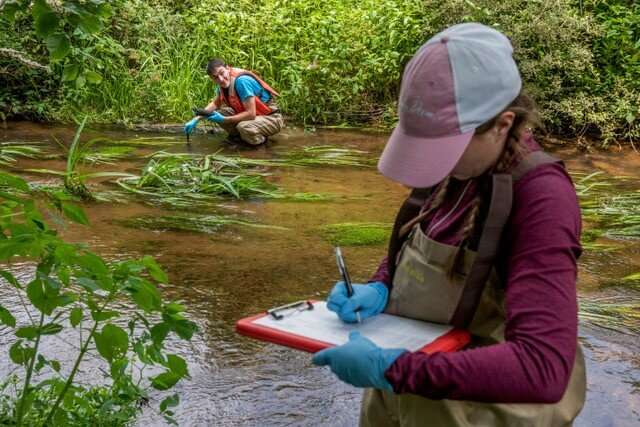EPA’s new PFAS rules don’t account for major source of drinking water contamination

Earlier this year, the US Environmental Protection Agency proposed maximum allowable levels in drinking water for six PFAS (per- and polyfluoroalkyl substances)—so-called forever chemicals. But the draft standards do not account for half of the PFAS at contaminated sites across the country.
The findings are from a team led by the Harvard John A. Paulson School of Engineering and Applied Sciences (SEAS) and are published in the journal Environmental Science & Technology.
PFAS are present in fire retardant foams among other products and have been building up in the environment since they were first invented by Dupont in the 1930s and manufactured widely by 3M beginning in the 1950s. Exposures to some PFAS are linked to a range of health risks including cancer, immune suppression, diabetes, and low infant birth weight.
PFAS compounds come in two forms: a precursor form and a terminal form. Most of the monitored PFAS compounds are terminal compounds. The EPA’s draft drinking water rules are for six terminal compounds that do not degrade under normal environmental conditions. Precursor compounds can be transformed through biological or environmental processes into terminal forms. There are many precursor compounds, most of which are not routinely monitored, and none are currently regulated.
The U.S. military is the largest global user of fire-retardant foams containing PFAS known as AFFF (aqueous film forming foam). For decades, hundreds of military bases across the U.S. and around the world used AFFF containing high levels of PFAS for fire training drills and fighting fires. AFFF use is one of the largest sources of PFAS contamination in drinking water.
“Many PFAS precursors present in AFFF are difficult to measure. This work shows that they are slowly transforming into PFAS of health concern at AFFF-contaminated sites and contributing to downstream contamination” said Elsie Sunderland, Fred Kavli Professor of Environmental Chemistry and Professor of Earth and Planetary Sciences at SEAS and senior author on the new paper.
Much of the PFAS at military sites consists of precursors that are omitted from standard analytical methods. Using a method previously developed in the Sunderland lab that captures all precursors in AFFF, the Harvard team modeled the expected duration and contribution of those precursors to groundwater contamination. The study finds that contamination of two of the newly regulated PFAS chemicals (perfluorohexane sulfonate: PFHxS and perfluorbutane sulfonate: PFBS) at one military base on Cape Cod, Massachusetts are sustained by microbial precursor biotransformation in the soil. These precursors are retained in the soil where they leach into groundwater in terminal form at concentrations thousands of times greater than the safe levels established by the EPA.
The researchers projected using a computer model and field data that, without remediation, widespread PFAS contamination of drinking water supplies near military facilities is likely to persist for centuries. Despite contamination of nearby aquifers that may already pose a risk to human health, the majority of PFAS are still sitting in the soils surrounding these contaminated sites, emphasizing the urgent need for advances in remediation technology that are effective at cleaning up both terminal and precursor compounds. Since regulations focus only on terminal compounds, the effectiveness of current remediation technologies at cleaning up precursors is not known.
The researchers concluded that elevated PFAS exposures downstream of more than 300 U.S. military facilities that used the fire-fighting foams could similarly persist for centuries.
“The role of PFAS precursors in sustaining hazardous levels of contamination at Joint Base Cape Cod raises concern about whether exposure risks are underestimated near hundreds of other sites where they are not measured” said Bridger Ruyle, the first author of the study and former doctoral student in Sunderland’s Lab.
The public comment period for EPA’s draft PFAS drinking water regulation closes on May 30. While a step in the right direction, there are thousands of PFAS chemical structures, several hundred of which have already been detected in the environment, Sunderland notes.
In related work also published in Environmental Science & Technology today, Sunderland’s group also has shown that the number of military fire training areas within a watershed is a good predictor for PFAS contamination in a community’s drinking water supply. But some groups are at higher risk than others; a forthcoming publication by the Sunderland lab documents marked sociodemographic disparities in exposures to PFAS and proximity to PFAS sources across the country.
Additional authors include Colin Thackray and Chad Vecitis of Harvard; Craig Butt of AB Sciex LLC; and Denis LeBlanc and Andrea Tokranov of the U.S. Geological Survey.
More information:
Centurial Persistence of Forever Chemicals at Military Fire Training 2 Sites, Environmental Science & Technology (2023).
Citation:
EPA’s new PFAS rules don’t account for major source of drinking water contamination (2023, May 15)
retrieved 15 May 2023
from https://phys.org/news/2023-05-epa-pfas-dont-account-major.html
This document is subject to copyright. Apart from any fair dealing for the purpose of private study or research, no
part may be reproduced without the written permission. The content is provided for information purposes only.
For all the latest Science News Click Here
For the latest news and updates, follow us on Google News.

